Day 01 : Arrive Delhi
Arrive Delhi International Airport Terminal 3 [flight details to be advised]
On arrival in Delhi, meet and assist at airport and transfer to hotel
Hotel check-in at 1400 hours
Rest of the day at leisure
Overnight stay at hotel in Delhi [B].
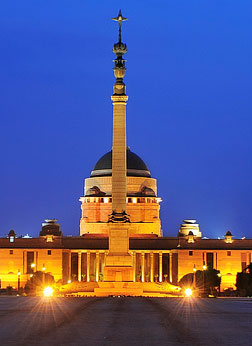 President House - Delhi
President House - Delhi
Day 02 : Delhi
Following breakfast at hotel, proceed for sightseeing tour of Old and New Delhi including a rickshaw ride (pedi cab) in Chandni Chowk [Red Fort is closed on Mondays]
Old Delhi - Situated in a strategic position on the west bank of the Yamuna River, between the Himalayas and the Aravalli Hills, Delhi is the gateway to the rich alluvial soils of the Ganges plain and has, according to Indian folklore, been occupied since 2500 BC. The original city, Indraprastha was the first of nine. Shahjahanabad or Old Delhi, the 7th city, was built when the Mughal Emperor moved his capital back to Delhi from Agra in 1638. Planned out in blocks with wide roads, residential areas and bazaars, Chandi Chowk, now thought to be Asia’s busiest street, was the main artery. Literally translated as ‘Silver Street’ this bustling market area of Old Delhi is good for hunting down new and antique gold and silver jewellery from craftsmen whose forefathers served the emperor. At the 1911 Delhi Durbar, King George V announced that the capital of India was to move from Calcutta to Delhi. Inaugurated in 1931, the ambitious work of British architects Sir Edwin Lutyens and Herbert Baker, New Delhi is an audacious statement of Imperial British control over India. Today the difference between bustling Old Delhi and the calmer, tree lined avenues of New Delhi is striking.
New Delhi – Was planned and built by the British in the 1920’s and is characterized by Sir Edwin Lutyens’ monumental architecture. Driving through the city, with its wide tree lined avenues discover India Gate and the Diplomatic Enclave, the Central Secretariat and the President's House. Visit Humayun's Tomb, aptly called the predecessor of the Taj Mahal because of its ornate Mughal style of architecture, later perfected in the Taj Mahal. Finally, see the 12th century Qutab Minar, considered one of the most perfect towers in the world, measuring 72m high. Continue to Connaught Place, New Delhi's main shopping area and central hub.
Rest of the day at leisure
Overnight stay at hotel in Delhi [B].
Day 3 : Delhi – Mandawa [Surface: 260 kms / 6 hours]
Following breakfast at hotel, check-out from hotel and transfer by road to Mandawa
On arrival in Mandawa, check-in at hotel
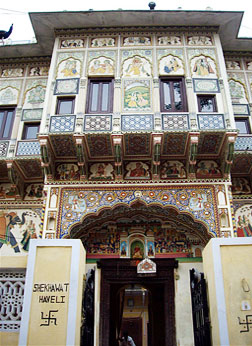 Shekhawat Haveli - Mandawa
Shekhawat Haveli - Mandawa
Afternoon proceed for sightseeing tour of Mandawa visiting the beautiful havelis
The small town of Mandawa, in the Shekhawati region of Rajasthan (often described as the ‘open air art museum’ of India) has many Havelis with extraordinary paintings and frescos on their walls. The Shiva temple in the town has a rock crystal lingam and the Harlalka baoli is a working step well which is worth visiting to observe the villagers raising water using oxen. The terrace of the rugged fort, built by Thakur Nawal Singh in the late 17th century provides an ideal vantage point for a panoramic view of the town.
Overnight stay at hotel in Mandawa [B].
Day 04 : Mandawa – Bikaner [Surface: 200 kms / 4 hours]
Following breakfast at hotel, check-out from hotel and transfer by road to Bikaner
On arrival in Bikaner, check-in at hotel
Afternoon proceed for sightseeing tour of Bikaner visiting Junagarh Fort, Lallgarh Palace and Camel breeding farm
An independent kingdom and affluent trading town, on the cross desert trading routes Bikaner was founded in 1488 by Rao Bhikaji, son of Rao Jodha the founder of Jodhpur. Perched on a rocky outcrop and dominating the town, the superbly preserved Junagarh Fort that was built in 1588 is a worth seeing. The Lal Niwas, richly decorated in red and gold is the oldest of the 37 palaces within the fort, and houses a library of Sanskrit and Persian books. The armoury also displays the Maharajas’ palanquins. Be sure to visit the Har Mandir Royal Chapel where royal weddings and births were once celebrated. The Lalgarh Palace, built of red sandstone and designed by Sir Swinton Jacob has an impressive collection of hunting trophies and photographs and gives a fascinating glimpse into the lives of 20th century Maharajas. A wonderfully preserved Bikaner State Railway Carriage can be seen in the garden.
Overnight stay at hotel in Bikaner [B].
Day 05 : Bikaner – Jaisalmer [Surface: 330 kms / 6 hours]
Following breakfast at hotel, check-out from hotel and transfer by road to Jaisalmer
On arrival in Jaisalmer, check-in at hotel
Rest of the day at leisure with car and driver at disposal
Overnight stay at hotel in Jaisalmer [B].
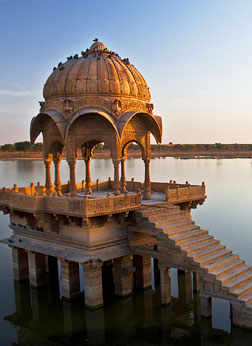 Gadisar Lake - Jaisalmer
Gadisar Lake - Jaisalmer
Day 06 : Jaisalmer
Following breakfast at hotel, proceed for sightseeing tour of Jaisalmer visiting Jaisalmer Fort, Salim Singh Ki Haveli, Patwon Ki Haveli, Nathmal Ki Haveli and Gadisar Lake
A tour of Jaisalmer begins at the Gadisar Tank in the south east of the town then continues to the fort perched on Trikuta Hill, 72m above the town. The fort’s outer walls, built between 1633 and 1647, are 9m high with 99 bastions. Inside the fort notice the beautiful doors and balconies of the tiny houses that are occupied by over 1,000 of the town’s population, making it India’s only ‘living fort’. Visit the seven-storey Juna Mahal Palace, one of the oldest palaces in Rajasthan that boasts wonderfully intricate jali screens. From the fort visit the Jain temples, which feature 6,666 exquisitely carved images of various Jain and Hindu deities. Proceed to Salim Singh-ki Haveli, a 17th century palatial marvel near the fort entrance. It is known as the ‘ship palace’ due to the distinctive design of the upper floors. Patwon-ki Haveli, a group of 5 ornate merchant’s houses built for 5 brothers have beautiful murals and carved pillars. With numerous decorated upper floor balconies and a pretty inner courtyard, Patwon-ki Haveli is one of the most impressive Havelis in Jaisalmer. Partially carved out of rock the façade of Nathmal-ki Haveli is highly decorated and reflects the status of its first inhabitant who was the Prime Minister of the time. The front door is guarded by 2 carved elephants. Finally, visit the cenotaphs, with elaborately carved images of kings on horseback; this is the perfect place to watch the sunset over Jaisalmer.
Evening visit to Sam sand dunes with camel ride
Overnight stay at hotel in Jaisalmer [B].
Day 07 : Jaisalmer – Jodhpur [Surface: 290 kms / 6 hours]
Following breakfast at hotel, check-out from hotel and transfer by road to Jodhpur
On arrival in Jodhpur, check-in at hotel
Rest of the day at leisure with car and driver at disposal
Overnight stay at hotel in Jaisalmer [B].
Day 08 : Jodhpur
Following breakfast at hotel, proceed for sightseeing tour of Jodhpur visiting Mehrangarh Fort and Jaswant Thada
Afternoon proceed for sightseeing tour of Jodhpur visiting Umaid Bhawan Museum, Mehrangarh Fort and Jaswant Thada [Umaid Bhawan Museum is closed on Mondays]
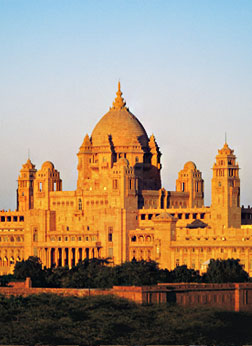 Umaid Bhawan Palace - Jodhpur
Umaid Bhawan Palace - Jodhpur
Lying on what was once the Delhi / Gujarat trading route, and known as the Blue City, the former capital of Marwar is the second city of Rajasthan. In 1459 Rao Jodha, forced from Mandore, selected a rocky range of sandstone hills on which to build his new city. He surrounded his new capital with a wall 10km long and 2.7m thick. Ranging from 4 to 9m in height with 7 gates, the wall is dwarfed by the huge and impregnable Mehrangarh Fort, which was built some 120m above the city. Rao Jodha originally started the fort, but Maharaja Jaswant Singh built the majority of the palaces. Upon his death in 1678 Aurangzeb occupied the fort until his own death, whereupon the fort returned to Ajit Singh the son of Maharaja Jaswant Singh. The fort remained the royal residence right up until the completion of the Umaid Bhawan Palace in 1943. Today the fort, with its incredibly beautiful palaces, houses impressive collections of miniature paintings, weapons and armoury, palanquins, howdahs and jewellery. Every October, to coincide with the brightest full moon in North India, the Rajasthan International Folk Festival takes place in the stunning setting of the fort. RIFF, voted one of the top 25 world music festivals by the influential Songlines magazine, showcases the best of both Indian and International artists in this, the most magical of settings.
Rest of the day at leisure with car and driver at disposal
Overnight stay at hotel in Jodhpur [B].
Day 09 : Jodhpur – Ranakpur – Udaipur [Surface: 300 kms / 6.5 hours]
Following breakfast at hotel, check-out from hotel and transfer by road to Udaipur en-route visiting Ranakpur Jain Temples [For this visit audio guide would be provided at Temple complex]
Ranakpur – In the heart of the stunning Aravalli Hills is one of 5 holy Jain sites and is a popular pilgrimage centre. The temples of Ranakpur were built in the 15th century and are beautifully crafted and well preserved. One of the biggest and most important Jain temple complexes in India, the site is dominated by the Adinath Temple, which is supported by 1,444 exquisitely carved pillars; no two of which are the same. [The temples are open for Non-Jains from 1200 hours until 1600 hours every day]
Fixed menu / buffet lunch at Maharani Bagh Orchard Retreat in Ranakpur
On arrival in Udaipur, check-in at hotel.
Rest of the day at leisure with car and driver at disposal
Overnight stay at hotel in Udaipur [B]
Day 10 : Udaipur
Following breakfast at hotel, proceed for sightseeing our of Udaipur visiting City Palace, Saheliyon Ki Bari and Jagdish Temple
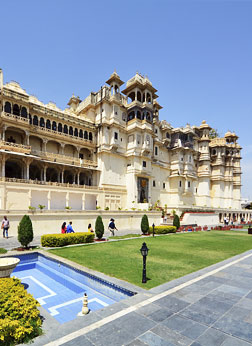 City Palace - Udaipur
City Palace - Udaipur
Udaipur – Was founded by Maharana Udai Singh, in 1567. Still very much a traditional Rajput town, it is one of the most picturesque and romantic towns in India. It has an impressive selection of world-class hotels and the city glows in the early evening as dusk falls over Lake Pichola. This is an ideal time to enjoy a boat ride to Jagmandir Island Palace. The second island on the lake is Jag Niwas Island, now more commonly known as the famous Lake Palace hotel, which featured in the James Bond movie Octopussy. The City Palace over-looks Lake Pichola and houses an impressive museum that includes an outstanding collection of miniature paintings. Every evening in the beautiful Manek Chowk of the City Palace is a sound and light show, which brings the history of the palace alive. The Jagdish Temple, dedicated to Lord Vishnu, was completed in 1651 and is covered with intricate carvings. At all times of the day melodic chanting and singing can be heard, however it is at the evening prayers that the temple really comes alive.
Rest of the day at leisure with car and driver at disposal
Evening boat ride on Lake Pichola by shared boat [subject to water level]
Lake Pichola – Situated in Udaipur city in the Indian state of Rajasthan, is an artificial fresh water lake, created in the year 1362 AD, named after the nearby Picholi village. It is one of the several contiguous lakes, and developed over the last few centuries in and around the famous Udaipur city. The lakes around Udaipur were primarily created by building dams to meet the drinking water and irrigation needs of the city and its neighborhood. Two islands, Jag Niwas and Jag Mandir are located within Pichola Lake, and have been developed with several palaces to provide views of the lake.
Overnight stay at hotel in Udaipur [B].
Day 11 : Udaipur – Pushkar [Surface: 290 kms / 5-6 hours]
Following breakfast at hotel, check-out from hotel and transfer by road to Pushkar
On arrival in Pushkar, check-in at hotel
Afternoon proceed for sightseeing tour of Pushkar visiting Brahma Temple and Ghats on Pushkar Lake
At the heart of the peaceful town of Pushkar is one of India’s most sacred lakes. It is believed that a lotus flower thrown by Brahma (The Creator) landed here, and subsequently the town has attracted Hindu pilgrims for centuries. The lake, with its bathing ghats is particularly beautiful at sunrise or sunset. Several of the town’s early temples were destroyed by Aurangzeb, but the Brahma Temple at the far end of the bazaar, as well as the Savitri Temple, dedicated to his first wife remain. Every year the Kartik Purnima is marked by the famous Pushkar cattle and camel fair. A mix of spiritual and commercial enterprises, the fair attracts thousands of people. During the fair this ancient religious village is transformed into a spectacular carnival. Giant Ferris wheels and open-air theatres are set up and on the nearby dunes; the trading of cattle and camels takes place. In the town, pilgrims bathe and worship
Rest of the day at leisure with car and driver at disposal
Overnight stay at hotel in Pushkar [B].
Day 12 : Pushkar – Jaipur [Surface: 150 kms / 3 hours]
Following breakfast at hotel, check-out from hotel and transfer by road to Jaipur
On arrival in Jaipur, check-in at hotel
Rest of the day at leisure with car and driver at disposal
Overnight stay at hotel in Jaipur [B].
Day 13 : Jaipur
Following breakfast at hotel, excursion to Amber to visit Amber Fort with Elephant ride uphill and jeep ride downhill
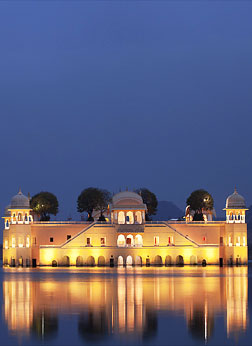 Jal Mahal - Jaipur
Jal Mahal - Jaipur
Amber – Originally the ancient capital of the Kachawahas clan from 1037 the ancient town of Amber, 12km from Jaipur, is dotted with ancient temples, Havelis, and step wells. High above the town and surrounded with defensive fortification walls sits the impressive Amber Palace. Built by Raja Man Singh in the early 17th century it houses mighty gates, temples, huge ornate halls, palaces, pavilions and gardens. Amber Palace is a perfect blend of Hindu and Muslim architecture and once at the top the Palace affords excellent views of the surrounding countryside and town below. The 10-minute walk though a series of five defensive gates will bring you to the Suraj Pol (Sun Gate), the main entry to the Palace. As an alternative it is possible to arrive at the Palace on the back of an elephant or drive up by jeep. Having visited the fort it is also possible to take a guided heritage walk of the often over-looked Amber village. This walk takes in seldom-visited temples, havelis, step wells and a fascinating museum of textiles.
Afternoon proceed for sightseeing tour of Jaipur visiting City Palace, Hawa Mahal and Observatory
Popularly known as the Pink City, Jaipur (City of Victory) is the state capital and largest city of Rajasthan. It was founded by Sawai Jai Singh II in 1727 and was planned according to Indian ‘Vastu Shastra’ principles. The city was divided into 9 blocks representing the ancient Hindu map of the universe; 2 blocks housed the state buildings and palaces, the other 7 allotted to various public buildings. A fortification wall was built around the city with 7 gates for entry. Originally, the buildings were painted in a variety of colours but in 1853 when Prince Albert visited, the old city was painted pink, a traditional colour of welcome. It has remained pink ever since. The City Palace in the centre of Jaipur took 4 years to complete. Tour the Palace by passing through the main entrance and begin by visiting the Mubarak Mahal, built in 1890 it houses the Textile and Costume Museum. Visit the Armoury then proceed through the Rajendra Pol gate into the main complex. Here the Diwan-i-Khas is home to 2 giant silver urns used by Sawai Madho Singh to carry Ganges water to England when he attended Queen Victoria’s Diamond Jubilee. After visiting the Chandra Mahal and the museums proceed to the Jantar Mantar Observatory. Built between 1728 and 1734 on a grand scale, the 17 astronomical instruments were built in stone and marble. The collection, built by Jai Singh includes the large Samrat, a 27.4m high sundial accurate to 2 seconds!
Rest of the day at leisure with car and driver at disposal.
Overnight stay at hotel in Jaipur [B].
Day 14 : Jaipur – Fatehpur Sikri – Agra [Surface: 250 kms / 6.5 hours]
Following breakfast at hotel, check-out from hotel and transfer by road to Agra en-route visiting Fatehpur Sikri
Despite having many wives, 26-year old Akbar had no living heir as all his children had died in infancy. Sheikh Salim Chishti, a Sufi saint living in the village of Sikri predicted Akbar would have three sons, and with the birth of Salim, (named after the saint and later known as Jahangir) and in recognition of the saint’s prophecy, Akbar built a new capital at Sikri in his honour. 37km southwest of Agra, this remarkable UNESCO World Heritage Site served as the Mughal capital from 1571. Due to an ever-increasing population and erratic water supply, the red sandstone city was abandoned in 1585. Fatehpur Sikri, the town of victory, was the Mughals first planned city to feature designs that amalgamated Hindu, Persian and Islamic design. Today, the complex of buildings, including the Diwan-i-Am and the Diwan-i-Khas, the Panch Mahal and Jodha Bai’s Palace are perfectly preserved.
Inside the Jama Masjid Mosque, completed in 1571 is the stunningly carved white marble tomb of Sheikh Salim Chishti. Today childless couples hoping for a son visit the tomb and in seeking the saints blessing tie a woolen thread to the outer Jali screens.
On arrival in Agra, check-in at hotel
Evening visit to Taj Mahal at sunset with tonga (horse carriage) ride [Taj Mahal is closed on Fridays]
Taj Mahal – Built by Emperor Shah Jahan in memory of his wife Mumtaz Mahal who died giving birth to their fourteenth child in 1631, the Taj Mahal is described by the Indian poet Rabindranath Tagore as ‘a tear drop on the face of eternity’. Heartbroken by her death, legend has it that Shah Jahan’s hair turned grey overnight and that he turned his back on running the empire, concentrating instead on the construction of this monument to love. Construction took 22 years and the Taj was completed in 1653 at a speculated cost of 3 million rupees, equivalent to around 70 million US Dollars today.
Overnight stay at hotel in Agra [B].
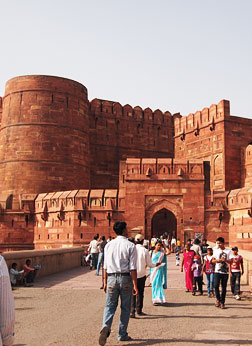 Red Fort - Agra
Red Fort - Agra
Day 15 : Agra – Delhi [Surface: 240 kms / 3.5 hours]
Following breakfast, morning at leisure
Hotel check-out at 1200 hours
Later check-out from hotel and visit Agra Fort and Itmad-ud-Daulah
Agra Fort – Massive and majestic, the red sandstone fort in Agra, built by Emperor Akbar, is perhaps the best-preserved fort in India. Construction of this crescent shaped fort 2.5km in circumference commenced in 1565. Contained within the huge double outer walls up to 20m high and broken by a series of huge gates, the fort is almost a city within a city. Initially the fort was a military structure but under the rule of Shah Jahan, Akbar’s grandson, many additions were added. The fort houses the Dewan-i-Khas and Dewan-i-Aam (Halls of Private and Public Audience) as well as the Musammam Burj and Khas Mahal, where Shah Jahan was imprisoned by his son Aurangzeb. Today these palatial buildings are silent witness to the rise and fall of the Imperial Mughal Empire and are exemplars of Islamic architecture and decoration.
Small, intimate and serene this well preserved exquisite mausoleum on the left bank of the Yamuna River was built between 1622 and 1628, and was commissioned by Noor Jahan, the wife of Emperor Jahangir in memory of her father Mizra Ghiyas Beg, a Persian nobleman and Wazir (Chief Minister) to Shah Jahan. Incorporating innovative design and extremely fine geometric latticework jali screens, daylight penetrates the building’s interior gently illuminating the ornately decorated walls and caskets. Older than the Taj Mahal, the ’Baby Taj’ was the first Mughal structure to be faced with white marble and inlaid with contrasting stones. The technique is known as ‘Pietra Dura’
Later transfer by road to Delhi
On arrival in Delhi, check-in at hotel
Overnight stay at hotel in Delhi [B].
Day 16 : Depart Delhi
Following breakfast at hotel, morning at leisure
Hotel check-out at 1200 hours
Later transfer to Delhi International Airport Terminal 3 to board flight for onward destination [flight details to be advised]